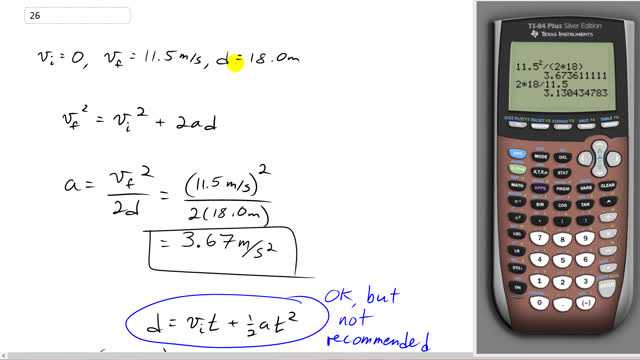
A world-class sprinter can reach a top speed (of about 11.5 m/s) in the first 18.0 m of a race. What is the average acceleration of this sprinter and how long does it take her to reach that speed?

In order to watch this solution you need to have a subscription.
This is Giancoli Answers with Mr. Dychko. We'll start this question by writing down the stuff that we know; we know the sprinter initially has a velocity of zero—they start from rest— and they reach a maximum speed of 11.5 meters per second over a distance of 18.0 meters. The unknown we are trying to find is acceleration so we can put that here too question mark and we need to consider all the different formulas we have and look for the one that has all these letters in it and basically a formula where you have everything known except for the single thing you want to find and this is the ticket because we know final speed, initial speed and we know distance and the only thing we don't know is a which means we just do some algebra and then we'll be able to use this formula. So v i is 0 so that term just disappears and we'll divide both sides by 2 times d and then switch the sides around so we have the unknown a on the left and we have a is final speed squared over 2 times the distance. So that's 11.5 meters per second squared divided by 2 times 18 meters and that gives 3.67 meters per second squared is the acceleration. To figure out how long it takes the sprinter to reach the speed—11.5—there's two formulas we could use; this one formula here will be fine because now we know acceleration and so the only thing we don't know is the t and so we can do some algebra and get t equals square root 2 times d over a. And that's okay but it's not recommended because you are using your own calculation, your own result in this formula and if you made a mistake on this one, that's also gonna make the result from this formula incorrect even if you do all your algebra correctly. So it's not recommended to use your own answers in subsequent calculations so I'm gonna say if you had to go ahead but there's a better way; we can use this formula because this contains only information given to us by the question. This says that the distance traveled is the average speed times time and we multiply both sides by 2 over v f plus v i, you know, the v i being zero but I guess we'll carry it through just to show the algebra and there we go. And then switch the sides around these cancel here and we have t equals 2 times d over the sum of the final and initial velocities. So we have 2 times 18 meters divided by 11.5 meters per second and that gives 3.13 seconds.
I noticed you called "d" distance, but aren't all the kinematic equations actually only referring to displacement?
Hi idan, you're quite right that the kinematics equations contain displacement, rather than distance. Often times, such as in this question, the two quantities have the same magnitude. The distance and the magnitude of the displacement are the same, in other words, but your comment and awareness that d is in fact always displacement is definitely important in questions for which that's not the case. Technically it's a mistake for me to refer to the factor d as a distance, but I fear that I probably do it quite often, making the distinction mostly just where it's necessary to do so. Hopefully this isn't too confusing!
All the best,
Mr. Dychko
Hi, I noticed when you were doing algebra of the formula : s = Vo + V / 2 x t to t = 2s / Vo + V. Shouldn't be 2s / Vo - V or am I just confusing everything haha :)
Best regards,
Kristel